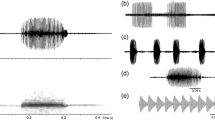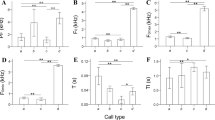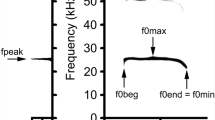Abstract
Non-hibernating pikas collect winter food reserves and store them in hay piles. Individualization of alarm calls might allow discrimination between colony members and conspecifics trying to steal food items from a colony pile. We investigated vocal posture, vocal tract length, and individual acoustic variation of alarm calls, emitted by wild-living Altai pikas Ochotona alpina toward a researcher. Recording started when a pika started calling and lasted as long as possible. The alarm call series of 442 individual callers from different colonies consisted of discrete short (0.073–0.157 s), high-frequency (7.31–15.46 kHz), and frequency-modulated calls separated by irregular intervals. Analysis of 442 discrete calls, the second of each series, revealed that 44.34% calls lacked nonlinear phenomena, in 7.02% nonlinear phenomena covered less than half of call duration, and in 48.64% nonlinear phenomena covered more than half of call duration. Peak frequencies varied among individuals but always fitted one of three maxima corresponding to the vocal tract resonance frequencies (formants) calculated for an estimated 45-mm oral vocal tract. Discriminant analysis using variables of 8 calls per series of 36 different callers, each from a different colony, correctly assigned over 90% of the calls to individuals. Consequently, Altai pika alarm calls are individualistic and nonlinear phenomena might further increase this acoustic individualization. Additionally, video analysis revealed a call-synchronous, very fast (0.13–0.23 s) folding, depression, and subsequent re-expansion of the pinna confirming an earlier report of this behavior that apparently contributes to protecting the hearing apparatus from damage by the self-generated high-intensity alarm calls.






Similar content being viewed by others
References
Blumstein DT, Verneyre L, Daniel JC (2004) Reliability and the adaptive utility of discrimination among alarm callers. Proc R Soc Lond B 271:1851–1857
Borg E, Counter SA (1989) The middle-ear muscles. Sci Am 261(2):74–80
Borg E, Counter SA, Rösler G (1984) Theories of middle-ear muscle function. In: Silman S (ed) The acoustic reflex – basic principles and clinical applications. Academic Press, Orlando, pp 63–99
Bouchet H, Blois-Heulin C, Pellier A-S, Zuberbühler K, Lemasson (2012) Acoustic variability and individual distinctiveness in the vocal repertoire of red-capped mangabeys (Cercocebus torquatus). J Comp Psychol 126:45–56
Briefer EF, McElligott AG (2012) Social effects on vocal ontogeny in an ungulate, the goat, Capra hircus. Anim Behav 83:991–1000
Broadbooks HE (1965) Ecology and distribution of the pikas of Washington and Alaska. Am Midl Nat 73:299–335
Brumm H, Schmidt R, Schrader L (2009) Noise-dependent vocal plasticity in domestic fowl. Anim Behav 78:741–746
Claes R, Muyshondt PGG, Van Hoorebeke L, Dhaene J, Dirckx JJJ, Aerts P (2017) The effect of craniokinesis on the middle ear of domestic chickens (Gallus gallus domesticus). J Anat 230:414–423
Claes R, Muyshondt PGG, Dirckx JJJ, Aerts P (2018) Do high sound pressure levels of crowing in roosters necessitate passive mechanisms for protection against self-vocalization? Zoology 126:65–70. https://doi.org/10.1016/j.zool.2017.12.002
Conner DA (1982) Geographic variation in short calls of pikas (Ochotona princeps). J Mammal 63:48–52
Conner DA (1984) The role of an acoustic display in territorial maintenance in the pika. Can J Zool 62:1906–1909
Conner DA (1985) The function of the pika short call in individual recognition. Z Tierpsychol 67:131–143
Conner DA, Whitworth MR (1985) The ontogeny of vocal communication in the pika. J Mammal 66:756–763
Déaux EC, Clarke JA, Charrier I (2016) Dingo howls: the content and efficacy of a long-range vocal signal. Ethology 122:649–659
Dillon WR, Goldstein M (1984) Multivariate analysis: methods and applications. Wiley, New York
Efremova KO, Volodin IA, Volodina EV, Frey R, Lapshina EN, Soldatova NV (2011) Developmental changes of nasal and oral calls in the goitred gazelle Gazella subgutturosa, a nonhuman mammal with a sexually dimorphic and descended larynx. Naturwissenschaften 98:919–931
Efremova KO, Frey R, Volodin IA, Fritsch G, Soldatova NV, Volodina EV (2016) The postnatal ontogeny of the sexually dimorphic vocal apparatus in goitred gazelles (Gazella subgutturosa). J Morphol 277:826–844
Engbers S, Larkin A, Rousset N, Prebble M, Jonnalagadda M, Knight CG, Pang DSJ (2017) Comparison of a supraglottic airway device (v-gel®) with blind orotracheal intubation in rabbits. Front Vet Sci 4:49. https://doi.org/10.3389/fvets.2017.00049
Fenton MB, Audet D, Obrist MK, Rydell J (1995) Signal strength, timing, and self-deafening: the evolution of echolocation in bats. Paleobiology 21:229–242
Fitch WT, Neubauer J, Herzel H (2002) Calls out of chaos: the adaptive significance of nonlinear phenomena in mammalian vocal production. Anim Behav 63:407–418
Frey R, Volodin IA, Fritsch G, Volodina EV (2016) Potential sources of high frequency and biphonic vocalization in the dhole (Cuon alpinus). PLoS One 11(1):e0146330. https://doi.org/10.1371/journal.pone.0146330
Furuyama T, Kobayasi KI, Riquimaroux H (2016) Role of vocal tract characteristics in individual discrimination by Japanese macaques (Macaca fuscata). Sci Rep 6:32042. https://doi.org/10.1038/srep32042
Gamba M, Favaro L, Araldi A, Matteucci V, Giacoma C, Friard O (2017) Modeling individual vocal differences in group-living lemurs using vocal tract morphology. Curr Zool 63:467–475
Gogoleva SS, Volodin IA, Volodina EV, Trut LN (2008) To bark or not to bark: vocalization in red foxes selected for tameness or aggressiveness toward humans. Bioacoustics 18:99–132
Hafner DJ, Smith AT (2010) Revision of the subspecies of the American pika, Ochotona princeps (Lagomorpha: Ochotonidae). J Mammal 91:401–417
Hare JF (1998) Juvenile Richardson’s ground squirrels, Spermophilus richardsonii, discriminate among individual alarm callers. Anim Behav 55:451–460
Hare JF, Atkins BA (2001) The squirrel that cried wolf: reliability detection by juvenile Richardson’s ground squirrels (Spermophilus richardsonii). Behav Ecol Sociobiol 51:108–112
Hayes AR, Huntly NJ (2005) Effects of wind on the behavior and call transmission of pikas (Ochotona princeps). J Mammal 86:974–981
Henson OW (1965) The activity and function of the middle ear muscles in echo-locating bats. J Physiol 180:871–887
Holmes WG (1991) Predator risk affects foraging behavior of pikas: observational and experimental evidence. Anim Behav 42:111–119
Huntly NJ, Smith AT, Ivins BL (1986) Foraging behavior of the pika (Ochotona princeps), with comparisons of grazing versus haying. J Mammal 67:139–148
Ivins BL, Smith AT (1983) Responses of pikas (Ochotona princeps, Lagomorpha) to naturally occurring terrestrial predators. Behav Ecol Sociobiol 13:277–285
Jansen DA, Cant MA, Manser MB (2012) Segmental concatenation of individual signatures and context cues in banded mongoose (Mungos mungo) close calls. BMC Biol 10:97. https://doi.org/10.1186/1741-7007-10-97
Jen PHS, Suga N (1976) Coordinated activities of middle-ear and laryngeal muscles in echolocating bats. Science 191:950–952
Klenova AV, Volodin IA, Volodina EV (2008) Duet structure provides information about pair identity in the red-crowned cranes (Grus japonensis). J Ethol 26:317–325
Klenova AV, Volodin IA, Volodina EV (2009) The variation in reliability of individual vocal signature throughout ontogenesis in the red-crowned crane Grus japonensis. Acta Ethol 12:29–36
Lapshina EN, Volodin IA, Volodina EV, Frey R, Efremova KO, Soldatova NV (2012) The ontogeny of acoustic individuality in the nasal calls of captive goitred gazelles, Gazella subgutturosa. Behav Process 90:323–330
Liao JC, Zhang ZB, Liu NF (2006) Altitudinal variation of skull size in Daurian pika (Ochotona daurica Pallas, 1868). Acta Zool Acad Sci Hung 52:319–329
Lin G, CI H, Zhang T, Su J (2008) Conformity to Bergmann’s rule in the plateau pika (Ochotona curzoniae Hodgson 1875) on the Qinhghai-Tibetan plateau. Acta Zool Acad Sci Hung 54:411–418
Lissovsky AA (2003) Taxonomy of Altai pika Ochotona alpina (Pallas, 1773) (Lagomorpha, Ochotonidae) from West Altai. Russian J Theriol 2:59–62
Lissovsky AA (2004) Contribution to age determination of pikas (Lagomorpha, Ochotonidae, Ochotona). Russian J Theriol 3:43–48
Lissovsky AA (2005) Comparative analyses of the vocalization of pikas (Ochotona, Mammalia) from alpina-hyperborea group. Bull Mosc Soc Nat Biol Ser 110:12–26 [In Russian]
Lissovsky AA (2014) Taxonomic revision of pikas Ochotona (Lagomorpha, Mammalia) at the species level. Mammalia 78:199–216
Lissovsky AA, Lissovskaya EV (2002) Diagnostics of pikas (Lagomorpha, Ochotonidae, Ochotona) from the Putorana plateau, eastern Siberia. Russian J Theriol 1:37–42
Lissovsky AA, Ivanova NV, Borisenko AV (2007) Molecular phylogenetics and taxonomy of the subgenus Pika (Ochotona, Lagomorpha). J Mammal 88:1195–1204
Lutton LM (1975) Notes on territorial behavior and response to predators of the pika, Ochotona princeps. J Mammal 56:231–234
Macarthur A, Wang LCH (1973) Physiology of thermoregulation in the pika, Ochotona princeps. Can J Zool 51:11–16
Markham OD, Whicker FW (1973) Notes on the behavior of the pika (Ochotona princeps) in captivity. Am Midl Nat 89:192–199
Matrosova VA, Volodin IA, Volodina EV (2009) Short-term and long-term individuality in speckled ground squirrel alarm calls. J Mammal 90:158–166
Matrosova VA, Volodin IA, Volodina EV, Vasilieva NA, Kochetkova AA (2010a) Between-year stability of individual alarm calls in the yellow ground squirrel Spermophilus fulvus. J Mammal 91:620–627
Matrosova VA, Volodin IA, Volodina EV, Vasilieva NA (2010b) Stability of acoustic individuality in the alarm calls of wild yellow ground squirrels Spermophilus fulvus and contrasting calls from trapped and free-ranging callers. Naturwissenschaften 97:707–715
Matrosova VA, Blumstein DT, Volodin IA, Volodina EV (2011) The potential to encode sex, age, and individual identity in the alarm calls of three species of Marmotinae. Naturwissenschaften 98:181–192
Matrosova VA, Schneiderová I, Volodin IA, Volodina EV (2012) Species-specific and shared features in vocal repertoires of three Eurasian ground squirrels (genus Spermophilus). Acta Theriol 57:65–78
Matrosova VA, Rusin MY, Volodina EV, Proyavka SV, Savinetskaya LE, Shekarova ON, Rashevska HV, Volodin IA (2016) Genetic and alarm call diversity across scattered populations of speckled ground squirrels (Spermophilus suslicus). Mamm Biol 81:255–265
McCowan B, Hooper SL (2002) Individual acoustic variation in Belding’s ground squirrel alarm chirps in the High Sierra Nevada. J Acoust Soc Am 111:1157–1160
Murrant MN, Bowman J, Garroway CJ, Prinzen B, Mayberry H, Faure PA (2013) Ultrasonic vocalizations emitted by flying squirrels. PLoS One 8(8):e73045. https://doi.org/10.1371/journal.pone.0073045
Muyshondt PGG, Claes R, Aerts P, Dirckx JJJ (2017) Sound attenuation in the ear of domestic chickens (Gallus gallus domesticus) as a result of beak opening. R Soc Open Sci 4:171286. https://doi.org/10.1098/rsos.171286
Nikolskii AA, Mukhamediev TD (1995) Spatial structure of the Altai pika. Bull Mosc Soc Nat Biol Ser 100:32–41 [In Russian]
Nikolskii AA, Mukhamediev TD (1996) On territorial conservatism of the Altai pika. Bull Mosc Soc Nat Biol Ser 101:15–29 [In Russian]
Nikolskii AA, Mukhamediev TD (1997) Home-range size in the Altai pika. Bull Mosc Soc Nat Biol Ser 102:20–29 [In Russian]
Nikolskii AA, Mukhamediev TD (1998) Sexual dimorphism and seasonal change of the song in Altai pika. Bull Mosc Soc Nat Biol Ser 103:9–20 [In Russian]
Nikolskii AA, Srebrodolskaya EB (1989) Vocal activity of the northern pika (Ochotona hyperborea) in the food storing season. Bull Mosc Soc Nat Biol Ser 94:22–29 [In Russian]
Nikolskii AA, Mukhamediev TD, Srebrodolskaya EB (1999) Seasonal changes in size of testicles and vocal activity of pikas suggests hormonal control of acoustic behaviour in mammals. Dokl Biol Sci 364:569–571 [In Russian]
Papale E, Buffa G, Filiciotto F, Maccarrone V, Mazzola S, Ceraulo M, Giacoma C, Buscaino G (2015) Biphonic calls as signature whistles in a free-ranging bottlenose dolphin. Bioacoustics 24:223–231
Pohlmann AG (1921) The position and functional interpretation of the elastic ligaments in the middle-ear region of Gallus. J Morphol 35:228–262
R Development Core Team (2009) R foundation for statistical computing. R Foundation for Statistical Computing, Vienna http://www.R-project.org
Randall JA, Rogovin KA (2002) Variation in and meaning of alarm calls in a social desert rodent Rhombomys opimus. Ethology 108:513–527
Riede T, Fitch T (1999) Vocal tract length and acoustics of vocalization in the domestic dog (Canis familiaris). J Exp Biol 202:2859–2867
Schneiderová I (2012) Frequency-modulated second elements of two-element alarm calls do not enhance discrimination of callers in three Eurasian ground squirrels. Curr Zool 58:749–757
Schneiderová I, Volodina EV, Matrosova VA, Volodin IA (2017) One plus one: binary alarm calls retain individual signature for longer periods than single-note alarms in the European ground squirrel (Spermophilus citellus). Behav Process 138:73–81
Sibiryakova OV, Volodin IA, Matrosova VA, Volodina EV, Garcia AJ, Gallego L, Landete-Castillejos T (2015) The power of oral and nasal calls to discriminate individual mothers and offspring in red deer, Cervus elaphus. Front Zool 12:2. https://doi.org/10.1186/s12983-014-0094-5
Sibiryakova OV, Volodin IA, Frey R, Zuther S, Kisebaev TB, Salemgareev AR, Volodina EV (2017) Remarkable vocal identity in wild-living mother and neonate saiga antelopes: a specialization for breeding in huge aggregations? Sci Nat 104:11. https://doi.org/10.1007/s00114-017-1433-0
Smith AT, Ivins BL (1984) Spatial relationships and social organization in adult pikas: a facultatively monogamous mammal. Z Tierpsychol 66:289–308
Solow AR (1990) A randomization test for misclassification probability in discriminant analysis. Ecology 71:2379–2382
Somers P (1973) Dialects in southern Rocky Mountain pikas, Ochotona princeps (Lagomorpha). Anim Behav 21:124–137
Stoeger AS, Baotic A, Li D, Charlton BD (2012) Acoustic features indicate arousal in infant giant panda vocalisations. Ethology 118:896–905
Suga N, Jen PH-S (1975) Peripheral control of acoustic signals in the auditory system of echolocating bats. J Exp Zool 62:277–311
Syrová M, Policht R, Linhart P, Spinka M (2017) Ontogeny of individual and litter identity signaling in grunts of piglets. J Acoust Soc Am 142:3116–3121
Takechi M, Kuratani S (2010) History of studies on mammalian middle ear evolution: a comparative morphological and developmental biology perspective. J Exp Zool (Mol Dev Evol) 314B:417–433. https://doi.org/10.1002/jez.b.21347
Terry AMR, Peake TM, McGregor PK (2005) The role of vocal individuality in conservation. Front Zool 2:10. https://doi.org/10.1186/1742-9994-2-10
Thompson AB, Hare JF (2010) Neighbourhood watch: multiple alarm callers communicate directional predator movement in Richardson’s ground squirrels, Spermophilus richardsonii. Anim Behav 80:269–275
Trefry SA, Hik DS (2009) Eavesdropping on the neighbourhood: collared pika (Ochotona collaris) responses to playback calls of conspecifics and heterospecifics. Ethology 115:928–938
Trefry SA, Hik DS (2010) Variation in pika (Ochotona collaris, O. princeps) vocalizations within and between populations. Ecography 33:784–795
Volodin IA, Volodina EV, Filatova OA (2005) Structural peculiarities, occurrence and functional significance of nonlinear phenomena in calls of terrestrial mammals. Zh Obshch Biol 66:346–362 [In Russian]
Volodin IA, Lapshina EN, Volodina EV, Frey R, Soldatova NV (2011) Nasal and oral calls in juvenile goitred gazelles (Gazella subgutturosa) and their potential to encode sex and identity. Ethology 117:294–308
Volodin IA, Volodina EV, Lapshina EN, Efremova KO, Soldatova NV (2014) Vocal group signatures in the goitred gazelle Gazella subgutturosa. Anim Cogn 17:349–357
Volodin IA, Volodina EV, Frey R, Gogoleva SS, Palko IV, Rozhnov VV (2017) Acoustic structure of alarm calls in Indian sambar (Rusa unicolor) and Indian muntjac (Muntiacus vaginalis) in South Vietnam. Dokl Biol Sci 474:110–113
Volodina EV, Volodin IA, Isaeva IV, Unck C (2006) Biphonation may function to enhance individual recognition in the dhole, Cuon alpinus. Ethology 112:815–825
Volodina EV, Volodin IA, Chelysheva EV, Frey R (2018) Hiss and snort call types of wild-living giraffes Giraffa camelopardalis: acoustic structure and context. BMC Res Notes 11:12. https://doi.org/10.1186/s13104-017-3103-x
Wever EG, Vernon JA (1961) The protective mechanisms of the bat's ear. Ann Otol Rhinol Laryngol 70:1–17
Wilden I, Herzel H, Peters G, Tembrock G (1998) Subharmonics, biphonation, and deterministic chaos in mammal vocalization. Bioacoustics 9:171–196
Wilson DR, Hare JF (2004) Animal communication: ground squirrel uses ultrasonic alarms. Nature 430:523
Wilson DR, Hare JF (2006) The adaptive utility of Richardson’s ground squirrel (Spermophilus richardsonii) short-range ultrasonic alarm signals. Can J Zool 84:1322–1330
Yorzinski JL (2017) The cognitive basis of individual recognition. Curr Opin Behav Sci 16:53–57
Zhang F, Zhao J, Feng AS (2017) Vocalizations of female frogs contain nonlinear characteristics and individual signatures. PLoS One 12(3):e0174815. https://doi.org/10.1371/journal.pone.0174815
Acknowledgements
We thank the staff of the Natural State Reserve “Khakassian” for the help and support and especially to Y. Semenov, for his assistance in the field. We thank the staff of the Zoological Museum of Moscow University S. Kruskop, V. Lebedev, and D. Galas, for providing museum skull specimens and assistance in handling. We thank the director of Tierpark Berlin and Berlin Zoo, A. Knieriem, for providing the specimen of O. daurica and G. Fritsch and J.B. Kühne of the CT facility at the Leibniz Institute for Zoo and Wildlife Research (IZW), Berlin, Germany, for scanning the O. daurica specimen and providing us the dataset. We thank the four anonymous reviewers for their valuable comments.
Funding
The study was supported by the Russian Science Foundation, grant 14-14-00237.
Author information
Authors and Affiliations
Corresponding author
Ethics declarations
Conflict of interest
The authors declare that they have no conflict of interest.
Ethical approval
This study has been conducted in collaboration with the staff of the Natural State Reserve “Khakassian,” in accordance with its research projects, with its ethical and animal welfare standards and with the Guidelines for the treatment of animals in behavioral research and teaching (Anim Behav, 2006, 71:245–253). Animal disturbance was kept at a minimum, and no animal was injured as a result of our work. The conservation status of the Altai pika is “Least Concern,” so there is no need for special conservation measures across its distribution area. The data collection protocol no. 2011-36 was approved by the Committee of Bioethics of Lomonosov Moscow State University.
Informed consent
Informed consent was not required.
Additional information
Communicated by: Sven Thatje
Electronic supplementary material
Rights and permissions
About this article
Cite this article
Volodin, I.A., Matrosova, V.A., Frey, R. et al. Altai pika (Ochotona alpina) alarm calls: individual acoustic variation and the phenomenon of call-synchronous ear folding behavior. Sci Nat 105, 40 (2018). https://doi.org/10.1007/s00114-018-1567-8
Received:
Revised:
Accepted:
Published:
DOI: https://doi.org/10.1007/s00114-018-1567-8




